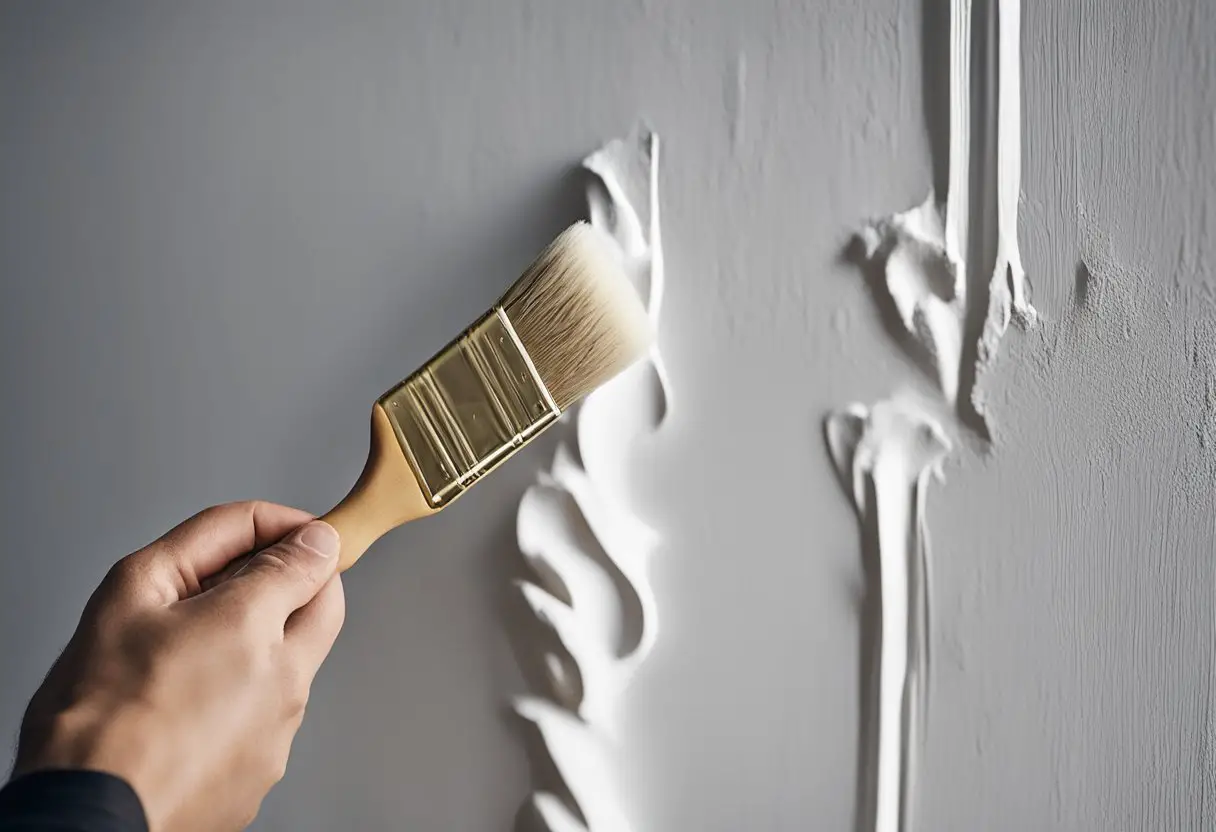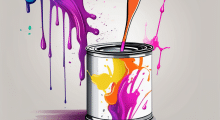Painting stucco can be a challenging task, but with the right tools, materials, and techniques, it is possible to achieve a beautiful and long-lasting finish. If you are planning to paint stucco, it is important to understand the characteristics of this type of surface and how to prepare it properly before applying paint.
Stucco is a type of plaster made from cement, sand, and water, which is applied to walls and other surfaces to create a textured finish. Because of its rough and porous surface, stucco can be difficult to paint, but with the right approach, it is possible to achieve a smooth and even finish. Before you start painting stucco, it is important to inspect the surface for cracks, chips, and other imperfections that may need to be repaired before painting.
Key Takeaways
- Understanding the characteristics of stucco is important before painting.
- Proper preparation is essential for achieving a smooth and even finish.
- Selecting the right paint and using the right painting techniques can help you achieve a long-lasting and beautiful finish.
Understanding Stucco
As a professional painter, I have worked with stucco on many occasions. Stucco is a popular building material that is used for exterior and interior walls. It is a mixture of cement, sand, water, and sometimes lime. Stucco is known for its durability and resistance to fire, making it a popular choice for homes and commercial buildings.
Types of Stucco
There are three main types of stucco: traditional, synthetic, and exterior insulation and finish systems (EIFS). Traditional stucco is made of cement, sand, and water. It is applied in multiple coats and is known for its strength and durability. Synthetic stucco, also known as exterior insulation and finish systems (EIFS), is made of foam insulation board and a synthetic stucco coating. It is lightweight and easy to install, making it a popular choice for new construction projects. However, it is not as durable as traditional stucco and can be prone to moisture problems.
Benefits of Painting Stucco
Painting stucco can provide many benefits. First, it can improve the appearance of your home or building. Stucco can become discolored over time due to exposure to the elements. Painting it can give it a fresh, new look. Second, painting stucco can protect it from the elements. Stucco is porous and can absorb moisture, which can lead to mold and mildew growth. Painting it can create a barrier that prevents moisture from penetrating the stucco. Finally, painting stucco can increase the value of your home or building. A well-maintained and painted stucco exterior can make a great first impression on potential buyers or tenants.
In conclusion, understanding stucco is important when it comes to painting it. Knowing the different types of stucco and the benefits of painting it can help you make an informed decision about how to approach your stucco painting project.
Preparation for Painting
Before starting to paint stucco, it is important to prepare the surface properly. This includes cleaning the surface, repairing any damages, and priming the stucco.
Cleaning the Surface
Cleaning the surface is the first step in preparing stucco for painting. The surface should be free of dirt, dust, and debris. Use a pressure washer to remove any loose dirt or debris. If necessary, use a soft-bristle vinyl brush to scrub the surface before washing it. Allow the surface to dry completely before proceeding to the next step.
Repairing Damages
Inspect the stucco for any damages such as cracks or holes. Fill any cracks or holes with stucco patching compound. Use a putty knife to apply the compound and smooth it out. Allow the compound to dry completely before proceeding to the next step.
Priming Stucco
Priming stucco is an important step in preparing the surface for painting. Primers help the paint to adhere to the surface and provide a smooth finish. Apply a coat of stucco primer using a roller or brush. Allow the primer to dry completely before proceeding to the next step.
By following these steps, you can ensure that the stucco surface is properly prepared for painting. This will help to ensure a long-lasting and professional-looking finish.
Selecting the Right Paint
When it comes to painting stucco, selecting the right paint is crucial. The right paint will not only make your stucco look great, but it will also protect it from the elements. Here are some things to consider when selecting the right paint for your stucco.
Paint Types for Stucco
There are two main types of paint to consider when painting stucco: elastomeric and masonry.
Elastomeric Paint: This type of paint is flexible and can stretch up to 600% of its original size. It is ideal for stucco because it can fill in small cracks and gaps, making it a great choice for older stucco homes. Elastomeric paint is also water-resistant and can help prevent moisture from penetrating the stucco.
Masonry Paint: This type of paint is thicker and more durable than traditional paint. It is ideal for stucco because it can withstand harsh weather conditions, such as extreme heat and cold. Masonry paint is also water-resistant and can help prevent moisture from penetrating the stucco.
Color Choices
When it comes to choosing a color for your stucco, there are a few things to consider.
Climate: If you live in a hot climate, you may want to choose a lighter color for your stucco. Lighter colors reflect the sun’s rays, which can help keep your home cooler. If you live in a cooler climate, you may want to choose a darker color to help absorb the sun’s rays and keep your home warmer.
Neighborhood: Consider the colors of the other homes in your neighborhood. You want your home to stand out, but you also want it to blend in with the other homes in the area.
Personal Preference: Ultimately, the color you choose is up to you. Choose a color that you love and that makes you happy every time you come home.
When selecting the right paint for your stucco, it’s important to consider both the type of paint and the color. With the right paint, your stucco can look great and be protected from the elements for years to come.
Painting Techniques

When it comes to painting stucco, there are a few different techniques you can use depending on the size of the area you are painting and the tools you have available. In this section, I will cover two of the most common techniques: using rollers and brushes, and the spray painting method.
Using Rollers and Brushes
If you are painting a smaller area of stucco, such as a patch or a small section of a wall, using rollers and brushes can be an effective method. Here are some tips to keep in mind:
- Use a thick-napped roller cover to ensure that the paint gets into all of the crevices and texture of the stucco.
- Use a paintbrush to cut in around the edges of the area you are painting.
- Apply the paint in thin coats, working in small sections at a time.
- Use a back-and-forth motion with the roller to ensure even coverage.
- Use a brush to smooth out any drips or uneven areas.
Spray Painting Method
If you are painting a larger area of stucco, such as an entire wall, using a spray painting method can save you time and effort. Here are some tips to keep in mind:
- Use a high-quality paint sprayer that is designed for use with stucco.
- Cover any areas that you don’t want to get paint on, such as windows or doors.
- Apply the paint in thin coats, working in small sections at a time.
- Hold the sprayer at a consistent distance from the wall to ensure even coverage.
- Use a back-and-forth motion with the sprayer to ensure even coverage.
- Wear protective gear, such as a respirator mask and goggles, to protect yourself from paint fumes and overspray.
By following these techniques, you can achieve a professional-looking paint job on your stucco surfaces.
Finishing Touches

After painting stucco, there are a few finishing touches that you can apply to ensure the longevity of the paint job. In this section, I will discuss two essential steps for finishing stucco painting: applying sealant and curing time.
Applying Sealant
Once the paint has dried, it’s a good idea to apply a sealant to the stucco surface. Sealant helps to protect the painted surface from moisture and other weather elements that can cause damage. It also helps to prevent the paint from peeling or chipping.
To apply sealant, you will need to choose a product that is compatible with the type of paint you used. There are many different types of sealants available, so be sure to read the label carefully before purchasing one. Apply the sealant to the stucco surface using a paintbrush or roller, and allow it to dry completely before touching or applying another coat of sealant.
Curing Time
After painting and applying sealant, it’s important to allow the stucco surface to cure fully before exposing it to any moisture or weather elements. Curing time can vary depending on the type of paint and sealant you used, as well as the weather conditions in your area.
As a general rule, it’s best to wait at least 24 hours before exposing the painted stucco surface to any moisture. This means avoiding any rain or humidity during this time. It’s also a good idea to avoid touching or applying any pressure to the surface during the curing time.
By following these two finishing touches, you can ensure that your stucco paint job lasts for many years to come.





